The chipboard is moisture resistant. OSB boards for outdoor use. How are OSB boards labeled?
OSB boards s (oriented strand board, OSB) is a popular material used primarily for express interior decoration, as well as in frame housing construction for outdoor work. In hardware stores, several brands are offered, characterized by different moisture resistance. OSB-1, OSB-2 are used for finishing interiors with normal humidity, OSB-3 and OSB-4 are designed for facing facades and external structures. The key feature of this building material is the natural origin of the raw material, high strength and low cost compared to wood.
Since it is simpler, coloration is often chosen as the outer coating. It is important to invest in paints with increased durability and resistance to sun and moisture. Typically, water-based acrylic paints are used and the finish is textured.
The biggest disadvantage of exterior paint is the frequent need for maintenance - because it is less stable, the paint may end up peeling or staining over time, requiring new coatings to provide protection and aesthetics to the façade structure.
You can also leave the facade of the house only with concrete. In addition to being an economical alternative, concrete-seeming concrete gives an industrial and versatile air to a building, requires a little care and is quite durable. Another widely used option is to create bricks in the form of a cover. This option requires more caution.
OSB: production features
Application OSB boards for outdoor work as a facing material cause it characteristics and production features. We are talking about the manufacture of building boards with a multilayer structure, usually 3 or more layers of material are used from small wood waste, glued together using boric acid, synthetic wax and resins. The most commonly used name in Russian is a direct transcription of the English translation, the correct abbreviation OSB comes from the name oriented strand board.
Self-assembly and finishing of OSB-sheets on the facade
People believe that wood cannot be applied to places that receive too much moisture or heat. However, wood is an extremely strong and durable material. Even in older structures, even the foundations were made of wood. Just take care - for example using varnish or waterproofing on the wood pieces to be used and the material will last a long time without cracking or showing signs of rotting.
You can also use two or more different claddings for the façade - such as wood and fillet stones - leaving it with a bold and unique look. Prices vary depending on the type and format of the chosen wood. Also be sure to analyze the finish and size of the selected items and always rely on the work of a professional to ensure best use coatings.
The strength of this facade material is comparable to and superior to hardwoods. At the same time, the presence of resins and wax in the surface treatment contributes to the preservation of a rigid structure and bearing capacity even when constantly wet. High hardness is also associated with the direction of the chip mass, in different layers of the plate it is located with different orientations - vertically and horizontally.
Indoor gardens leave the house full of life and allow plant lovers to stay close to them longer, even in winter. Check out these ideas and plan your own. Harmony prevails in the living room of the house. Environment receives natural light through the winter garden. The outdoor area is a kind of oasis next to the room.
Consumer characteristics - weight, thickness, size
The upstairs bedroom also has natural light due to the conservatory. A dark pine panel appeared in the corridor of the winter garden, on which hung an apron and accessories. In vases, swords-saints-george. In the background, ferns provide natural cover.
Depending on the application, a classification of brands has been introduced:
- OSB-1 - used to make non load-bearing structures operating in dry rooms;
- OSB-2 - for load-bearing structures in interior spaces;
- OSB-3 - for load-bearing structures at high humidity, including facades;
- OSB-4 - for structures that carry an increased load and are operated in conditions of high humidity;
- lacquered OSB boards - for finishing without additional coating;
- laminated - for concrete formwork;
- tongue-and-groove - with tongue-and-groove fastening on four sides, mainly for laying indoors (large floors).
OSB-3 and OSB-4 grades are used for exterior cladding of facades, more often OSB-3, as it has a much lower cost. The use of OSB-4 is recommended in structures with small roof overhangs, with a systematic wetting of the facade and the absence of a drainage system (in order to avoid or minimize wetting, specialized moisture-resistant paints and coatings are additionally used).
The conservatory of this house occupies both sides of the stairs between the dining room, in the front block and the gourmet area. In the winter garden of this apartment there is a small sofa with cushions to enjoy the area. The winter garden, located between the residential and gastronomic areas, was filled with plants of shades such as palmetto palisade, picosperma palms and singfons.
With perennial species and intermediate content - golden rain orchid, deer antler, goldfish and ivy - the conservatory is used without much concern. With pots arranged on a wooden grate on the wall, forming a vertical panel. The bathrooms in the suites on the ground floor, in this 250 m² house, have a windowed door to the conservatory created in a side recess.
Advantages of OSB boards as a facade material
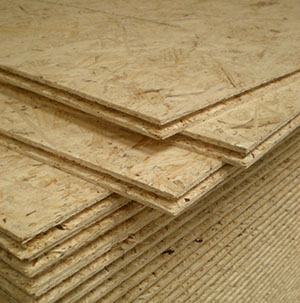
OSB-3 and OSB-4 grades are an improved version of chipboard. Short-term resistance to moisture, low vapor and water permeability - qualities characteristic of all types of OSB. Moisture-resistant brands change their dimensional parameters by only 7-10% after 24 hours in water. In terms of swelling coefficient, OSB is inferior to cement-bonded particle board, but it is much lighter in weight. It does not require laborious installation, it can be installed on high-rise structures without additional crane equipment.
The entrance staircase to the upper floor rests on a metal structure, next to the inner garden, where a fig tree has been preserved. In the double suite, in place of the Venetian, the closure is made by a sliding glass door that opens onto a balcony with the same width of the façade. In the other corner of this balcony there is a winter garden with a door that regulates the entrance of light and ventilation in the room.
Regardless of the size of the property, it is always possible to have a green space to connect with nature. You don't need a big backyard to have a garden. In fact, you don't even need to live at home. At right choice it is possible to grow plants on balconies, small outdoor areas, and even indoors without stealing public space. What you can't do is stay away from the green.
Table 1. Strength characteristics (slabs up to 1 cm thick)
|
Parameter, MPa |
|||
|
Flexural strength (static) |
|||
|
Flexural Elasticity (static) No matter how small the balcony is, there are plants there. To do this, put on pots and flower pots on the floor or shelves. Hanging from the ceiling or fixing them on the walls are also good outlets. It is possible to have even a fruit tree. And even if your apartment has a balcony, don't worry. This does not eliminate the flower pots scattered in different corners. These boards are made up of thin strips of wood glued together with a binder underneath. high pressure. This process makes the plates very resistant and gives them a very interesting properties for the construction of buildings and passive houses. As a rule, the binders used to glue wooden planks are moisture resistant. |
|||
|
Tensile Strength |
|||
|
Longitudinal tensile strength |
The key advantages of OSB as a facade material for cladding include the following qualities:
Matt thanks to the absorption of light Natural and pleasant appearance for interior Good acoustic isolation. Inevitably for wall walls, roofs, floors, but the scale does not stop there, it can be said that only the imagination is the limit of its application.
A few examples in the photos that inspire you at the end of the article! Using dilution and the absence of formaldehyde, almost no waste is produced. The small waste they produce is used as fuel. The bark is used in gardening.
- moisture resistance with a low coefficient of swelling in a humid room;
- easy processing comparable to wood (fasteners, staining, gluing);
- holds fasteners better than softwood plywood by 20%;
- practically has no defects (irregularities and voids);
- not damaged by rodents and insects.
Improved characteristics of the third and fourth grades of OSB are achieved due to the formulation of the adhesive base used. Multi-layer construction is performed using different types of resins:
A wide range of wood products are available with various functions and are comfortable to use, including during damp room and outdoors. Wood panels are wood derivatives that are easy to process. The agglomerate consists of wood particles glued together.
- The raw material is more or less smooth, its edges are irregular.
- For predominantly practical and utilitarian use.
- Use water repellents.
- Easy to paint or decorate: paintwork, lacquer, veneer.
- Easy to work with good holding assemblies.
- outdoor with increased moisture resistance - based on melamine-formaldehyde resin;
- internal - based on urea-formaldehyde resin, in some cases (in case of violation of technology) phenol-formaldehyde;
All resins used have increased toxicity in production, emit toxic substances. For this reason, with an unclear origin of building materials, OSB is used only for outdoor structures. In outdoor conditions, the released concentrations of toxins are insignificant, completely safe for humans and nature.
- Choice of colors and embellishments: matte, smooth, matte or glossy finishes.
- Easy to maintain, the panel is cleaned with water.
- Resistant to scratches and heat when laminating.
- Low flexibility and flexibility, depending on the thickness of the panel.
- The aspect is more raw than particle board.
- For more practical than decorative use.
- Easy to saw and drill.
Geography of production as an indicator of quality
Despite the fairly affordable technology, there are only a few of the largest manufacturers of OSB boards in the world. The main production facilities are located near large woodworking enterprises: Kronospan (Austria), Norbord (Belgium), Louisiana Pacific (USA), Glunz, Ainsworth (Germany).
A number of large-scale production facilities were built in China, but the value of raw materials is low, much inferior to the products of the EU countries, the USA and Canada. In addition to using more toxic resins, poplar shavings are used. It is significantly inferior in terms of strength compared to softwood.
What is OSB
There are different types of plywood for dry, wet or marine use.
- Flexibility up to 10 mm.
- Good impact resistance from 15 mm thick.
- Several possible finishes: paintwork, varnish, veneer.
For formwork in a wet room.
- Laminated or laminated, thickness 38mm.
- Waterproofing 28 mm thick.
- Waterproofing plywood 25 or 30 mm thick.
In Russia, the first production was launched in 2012 in the city of Kirov, in the Vladimir region (Hilman), the Kalevala DOK is operating, and the Kronospan plant in the Moscow region is expected to be put into operation. To date, production for the production of OSB-3 and OSB-4 is operating in the city of Torzhok, and projects have also been announced in Komi, Bashkiria, the Pskov region and Siberia.
The quality of the plates directly depends on the supplier, the cost - on the region of delivery. Russia is characterized by the deployment of new production lines and the use of coniferous wood shavings. Chinese OSB is not in demand due to unstable parameters. The most popular brand is Kronospan, which guarantees stable quality and environmental safety. Due to its features, OSB is one of the best materials for facade cladding, but with non-guaranteed quality, it is not recommended for use in interior decoration.
Which product should be used as a wood frame for floors, walls and roofs? The role of cladding. Seam cladding must first be distinguished from external cladding. In Quebec, the term "cladding" is commonly used for aluminum exterior cladding, flooring or tiling. Technically, the coating covers the wooden frame.
For walls. The role of the coating is primarily to give stability to the frame of the wood studs. A poorly fixed frame does not resist strong winds well. Wall cladding also serves to support the outdoor air barrier, which is responsible for the airtightness of the walls and soundproofing the walls from outside noise. floors or floor coverings are mainly used as a support for floor finishing. They must be rigid and very dimensionally stable to avoid damage to the coatings.
Consumer characteristics - weight, thickness, size
Trading companies offer OSB boards in a range of thicknesses and sizes. This product is not standardized and is therefore supplied in acceptable factory sizes. The available assortment and thickness range allows you to choose the most suitable option, managing the finishing work budget. Smaller sheets are suitable for do-it-yourself fastening and cladding, they are supplied by American and European manufacturers. The weight of products with the same parameters of thickness and size may vary slightly.
For roofs. Roofing is used to anchor and support roofing materials. They must be very resistant to moisture and retain the nails of roofing materials. Oriented particle board. Oriented particle boards are made from large rectangular chips bonded together with water-repellent adhesive. The chips are crossed to provide high resistance in both directions of the panels. Several layers of these are heated and pressed at very high pressure to bond them to an adhesive resin.
Table 2. Technical parameters of OSB boards from European manufacturers
NordBord manufactures products with a size of 2550 * 590 mm with a tongue-and-groove fastening on 4 sides, it is mainly used for laying floors. OSB boards are available for purchase individually and in packages, the quantity per pallet depends on the thickness of the sheet. With a thickness of 10 mm, 90 pieces are included in the package.
The result is a very rigid and moisture resistant panel. Plywood Plywood is a panel of layers of wood leaves unrolled from the tree like a roll toilet paper. The sheets are glued together, crossing the direction of the wood fibers. This results in panels that are very dimensionally stable and resistant to moisture.
It is also easy to obtain from well-managed forests from an ecological point of view. Cutting mature trees is more environmentally damaging. Plywood is stronger and more stable. Floor construction is often carried out in the presence of rain and sometimes snow. After swelling, contractors dry the joints to level the base, but this practice can affect the quality of the substrate. A priori, plywood is the best choice. They even have small drip holes next to the joints to reduce their swelling.
Table 3. Features of European-made OSB boards
|
Name |
Peculiarities |
|
Ecological cleanliness |
European-made boards can be used for interior and exterior decoration, controlled by the E1 environmental safety standard. In the Russian Federation, a certificate of hygiene has been received. Synthesis of the goals of the competitionBoth products certainly have their place in residential construction. Also the next video. For alpine shelters, medium-sized buildings or huts located in mountain resorts, usually away from settlements, designed to accommodate climbers and tourists in bad weather or at night, and can also serve as a foothold. The hut is located at an altitude of 544 m above sea level, at the end of the Wallelung, near the border with Austria. The hut is the starting point for high altitude trips in the Alpine Alps region. It cannot be reached by vehicles. Currently supplies are transported every two weeks or need a cable car which is currently in operation. The refuge is currently in a poor state of conservation, in terms of structures, plants and finishes; so it needs to be demolished and then rebuilt. |
|
moisture resistance |
Swelling ratio: |
|
Deformation |
It does not deform, so it can be used for load-bearing structures. Sheets do not have internal tension, as, for example, remains in the manufacture of plywood. |
|
Biostability |
Not damaged by mold, fungus, insects. Does not require additional processing. |
|
Dimensions and thicknesses |
Stable dimensions are ensured by computerization of production. |
|
Carpentry |
Easy sanding, sheets do not have defects, cracks, knots and voids. |
|
Installation Requirements |
Fastening is done with nails using a pneumatic tool, self-tapping screws, staples. |
OSB-3 and OSB-4 with a thickness of 15-25 mm are used for external cladding of facades. The cladding has low vapor permeability and does not require the installation of a vapor barrier. The spacing of the slabs during laying provides the necessary micro-ventilation.
Self-assembly and finishing of OSB-sheets on the facade
OSB installation is assessed at the technology level as a low-labor job that can be done independently. Without the involvement of assistants, it is recommended to pre-cut the sheets into several parts, mount on the wall using a mounting tool.
The next step is to paint the OSB. Facing a house using this type of material can be completed in 7-10 days with a complete finish. OSB sheets are covered with putty, plaster, ordinary and specialized facade paints, including those without a pre-applied leveling layer. In some cases, the house is finished with a contrast rail in the popular half-timbered architectural style.
Frame houses, which are gaining more and more popularity, do not raise doubts about their practicality and operational efficiency. But what can be said about the construction process itself and the materials that are used to build such buildings?
The main types of building materials for such structures are wooden beams, beams and OSB panels. It is the use of panels that provides frame house those characteristics that so attract developers.
What is OSB
For those who are planning to build a house from these materials, one should know not only the meaning of the abbreviation, but also the qualities that they possess, as well as functional differences from other similar materials.
 OSB panels are boards made from wood chips.
OSB panels are boards made from wood chips.
The meaning of the abbreviation translated from of English language stands for Oriented Strand Board.
The difference between these panels and chipboard boards familiar to domestic developers lies in the laying method and the type of chips. If in chipboard the main component is pressed in a chaotic manner, then OSB panels in their structure contain chips laid in one direction, that is, oriented.
It is characteristic that the stacking of chips is carried out in each layer in a different direction. The number of layers in each plate is three or four. Typically, the direction of chip placement is taken in the following order:
- First layer - fibers are placed in parallel to the panel structure
- The second layer always contains the chip direction perpendicular to the direction of the first layer.
- Third layer - again laying is done in the same way as the first layer
- Fourth layer - perpendicularly placed fibers
In some embodiments of the panels, a different method of chip pressing is adopted, which includes the parallel arrangement of the chip fibers in the outer layers and their transverse placement in the two inner layers.
To create a sandwich panel from OSB, chips up to 15 cm long are used, which are pressed under high pressure. Their volume in the structure of the plate reaches 90 percent. The bonding of the chip fibers is made with waterproof resins of synthetic origin.
As evidenced by the numerous reviews of developers who have used this material in the construction of their homes, it is this structure that provides a lot of advantages for operating a house. One of them, which allows saving the consumption of energy resources during the heating period, is the high heat capacity of OSB boards.
Classification of OSB panels
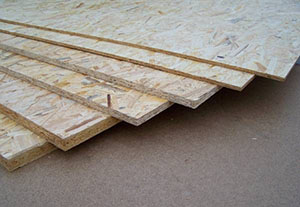 For construction purposes, it is recommended to use certain types of panels, since the structure and properties different types different and not always suitable for the same purposes.
For construction purposes, it is recommended to use certain types of panels, since the structure and properties different types different and not always suitable for the same purposes.
Reviews about the qualities of OSB panels lean towards the conscious choice of only certain categories of such panels.
In order not to make a mistake when ordering a material, you need to study the characteristic parameters and classification of OSB boards. Moreover, this is not difficult to do - there are only four of them, and the differences mainly relate to the number of layers, the degree of strength and moisture resistance indicators:
- OSB-1 panels are boards with a very low degree of strength and a low level of moisture resistance. In construction, such panels can only be used in interior work. But more often their use is common in the manufacture of furniture structures, as well as for packaging products.
- OSB-2 boards - have low strength, although slightly higher than the panels of the first category. They can also be used in interior finishing work, sometimes in the construction of light structural elements, ceilings and partitions. But due to low moisture resistance, it is not recommended to use it in basements, when finishing basement floors and in interior work in bathrooms and kitchens
- OSB 3 is the most common model of OSB panels. She excels in indoor and outdoor work. Can be used in different parts of the building. Resistant in humid environments
- OSB-4 category panel - the most durable brand of OSB boards used in all types of construction works. Due to its high strength, it can be successfully mounted on the outer parts of the building structure, when constructing roofs and attics. Excellent resistance to moisture, so it is used in the lower parts of the building and rooms with high humidity
All these properties, inherent in each category of panels to varying degrees, are achieved by using an adhesive base of various compositions. Moisture resistance of such plates is due to resinous glue compounds, and strength - to the arrangement of fibers wood shavings and the number of layers in the slab.
Differences in OSB boards are available by type of coating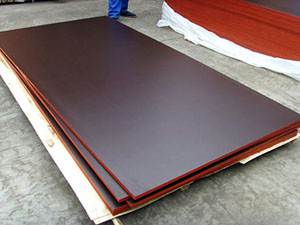 The industry produces panels with a laminated surface, which can be used as formwork, and more than once. For decorative purposes, boards are also available lacquered on both sides or on one side.
The industry produces panels with a laminated surface, which can be used as formwork, and more than once. For decorative purposes, boards are also available lacquered on both sides or on one side.
For the device of horizontal surfaces, panels are produced with connecting elements on the principle of a laminate board. On two or four sides of such panels there are end combs and grooves for connecting adjacent plates.
Reviews about OSB panels from buyers are inclined to believe that they have a perspective in the production of finishing works, they can be an excellent alternative in flooring.
Properties of OSB panels
Feedback from buyers of panels and developers note several significant advantages of this material:
- The technology of laying wood chips and the length of the chips make the OSB panels more rigid, which allows them to gain resistance to mechanical stress
- Thanks to the method of conveyor production, the dimensions specified by the technological requirements are observed in the plates. For the same reason, uniformity of thickness is achieved in all parts of the plate. This quality contributes to the ease of installation of OSB boards.
- Reducing the complexity of the installation process, increasing the efficiency of construction. The panels are lightweight, can be easily transported and do not create additional difficulties during loading and unloading operations.
- High thermal insulation performance is another significant advantage of this material. This property is achieved due to the high concentration of wood components known for thermal insulation properties.
- Availability in the process of processing - OSB can be easily subjected to grinding, drilling, cutting. And when driving nails, the edges of the plate do not crumble
| OSB properties | plate thickness 12mm |
| Length deviation, mm | +/-3 |
| Deviation in width, mm | +/-0,3 |
| Thickness deviation, mm | +/-0,8 |
| Deviation from right angle, maximum, mm/m | 2 |
| Bending resistance, main axis, MPa | 20 |
| Bending resistance, lateral axis, MPa | 10 |
| Modulus of elasticity in bending, main axis, minimum, MPa | 3500 |
| Bending modulus, lateral axis, minimum, MPa | 1400 |
| Swelling in thickness for 24 hours, maximum, % | 15 |
| Density, kg / m 3 | 630(+/-10%) |
| Humidity, % | 5-12 |
| Thermal conductivity, W/(mK) | 0,10 |
| Formaldehyde content, mg/100g | <8мг/100г |
As for the specific use of slabs in the construction of houses using frame technology, in their reviews, many builders and owners of ready-made residential buildings note the speed of construction and ease of installation work.
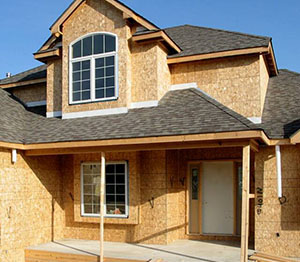 With regard to operation, undeniable advantages are also noticeable:
With regard to operation, undeniable advantages are also noticeable:
- Houses made of OSB panels do not give precipitation due to the lightness of the material
- In winter, there is a noticeable saving of energy resources, which eases the budgetary burden
- The ability to carry out additional planning of the premises without major intervention in the integrity of the structure
At the same time, in the reviews, one can also notice the absence of negative qualities inherent in other materials, namely, susceptibility to the process of decay, the presence of formations in the form of knots and voids inside the panel, and the risk of fire is reduced.
Against the background of such a volume of advantages, the individual disadvantages of OSB boards seem insignificant, but they cannot be ignored.
Among the main disadvantages of this material is the presence of phenol in adhesive resins, which can adversely affect health. However, in each category of plates listed above, the content of this element is regulated.
So when choosing plates for a particular application, you need to focus on their main purpose. For example, OSB-3 is best used in outdoor work, and OSB-2 is recommended for interior decoration.
Painting OSB panels
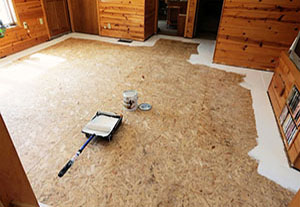 The application of paint materials on OSB panels does not require special conditions. For this purpose, any paint on wood can be used.
The application of paint materials on OSB panels does not require special conditions. For this purpose, any paint on wood can be used.
For better adhesion to the surface of the plate and a longer shelf life, the surface of the panel can be primed.
For interior work on panels, you can use acrylic varnish. For the same purpose, stain or water-based paint is used. In relation to all options, only positive reviews are noted.



